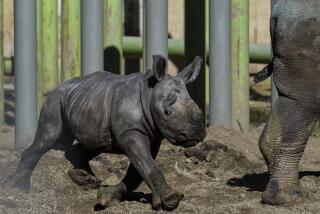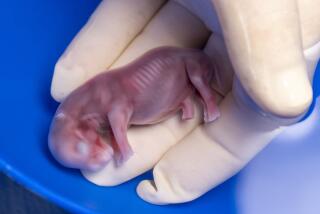South Africa Fights to Save Black Rhinos
- Share via
PILANESBERG, South Africa — Ranger Steve Johnson followed the saucer-sized tracks for most of a searing day to get his first glimpse of the Pilanesberg Game Reserve’s most treasured new addition.
“There,” he said, pointing through dense thorn bush to a gray shadow barely visible in the failing twilight. “Isn’t that just beautiful?”
His whisper startled the big rhino cow. Snorting in alarm, she tossed her heavy head and went crashing deeper into the scrub with a squealing 2-week-old calf at her heels.
That calf could play a crucial role in South Africa’s last-ditch campaign to save Africa’s black rhinoceros from extinction.
Rhinos have roamed the plains of Africa for 60 million years. Of 30 species known to have existed, the black rhinoceros is among five that still survive, but only just.
The hook-lipped black rhino, which browses on the lower leaves of bushes and trees, is smaller and more aggressive than the white rhino, whose square lip is adapted to grazing.
From hundreds of thousands in the 19th Century, the black rhino population dropped to 60,000 in 1970 and 3,500 today.
Thousands were wiped out by white settlers to clear land for farming. More recently, hunters armed with anything from a wire noose to a machine gun have harvested thousands more for their horns of densely compressed hair.
At its current rate of decline, the black rhinoceros will be extinct in five years. But John Ledger, director of South Africa’s privately funded Endangered Wildlife Trust, is committed to making sure that does not happen.
“The black rhino is an ill-tempered and dangerous animal. It is not compatible with high-density human settlement. But it is the horns he carries on his forehead that really threaten his survival,” he said.
At current prices, the horns on that Pilanesberg calf could grow to be worth $500 each to a poacher and as much as $50,000 on the black markets of Asia and the Middle East.
Rhino horn is prized in Yemen, the biggest market, for handles on traditional daggers that sell for as much as $20,000.
In Asia, powdered rhino horn is coveted at prices rivaling that of gold for medicines and, to a lesser extent, as an aphrodisiac.
“We have toyed with the idea of cutting the horns from every black rhino we can catch to destroy their value to poachers,” Ledger said.
“We have even thought about flooding the market with a synthetic substitute, but we can’t exactly match the smell.”
South Africa has outlawed the sale or export of rhino horn, and most countries restrict its import and sale. But as the price goes up, the risk to poachers becomes more worthwhile.
“The only real hope is to encourage breeding in protected areas,” Ledger said.
The numbers are so low that conservationists have had to introduce genetic management, swapping animals from one area to another to avoid in-breeding.
The small Pilanesberg Game Reserve, formed by the crater of an extinct volcano north of Johannesburg, is on the front line of the battle to save the black rhino.
“We are relatively rich in black rhino,” Johnson said. “With that little fellow and two more new arrivals we have spotted from the air, we will be able one day to swap with other parks to maintain adequate genetic variety.”
In Namibia, Ledger’s trust runs a program to train desert tribesmen in the northwestern Kaokoveld region as game wardens.
Patrolling with donkeys, binoculars, a water bottle and a bedroll, they have turned the tide for the desert rhino, whose numbers have risen in a few years from 57 to more than 100.
In neighboring Zimbabwe, the government is trying to save about 600 surviving black rhino. At least 32 poachers have been shot and killed in a ruthless campaign against poaching.
But still the massacre continues.
“South Africa’s black rhino population was almost wiped out when the interior was settled over 100 years ago. What is happening further north today is probably no worse than what happened here in the last century,” Ledger said.
“We helped to destroy them, and it is up to us in South Africa to make sure they survive.”
More to Read
Sign up for Essential California
The most important California stories and recommendations in your inbox every morning.
You may occasionally receive promotional content from the Los Angeles Times.













